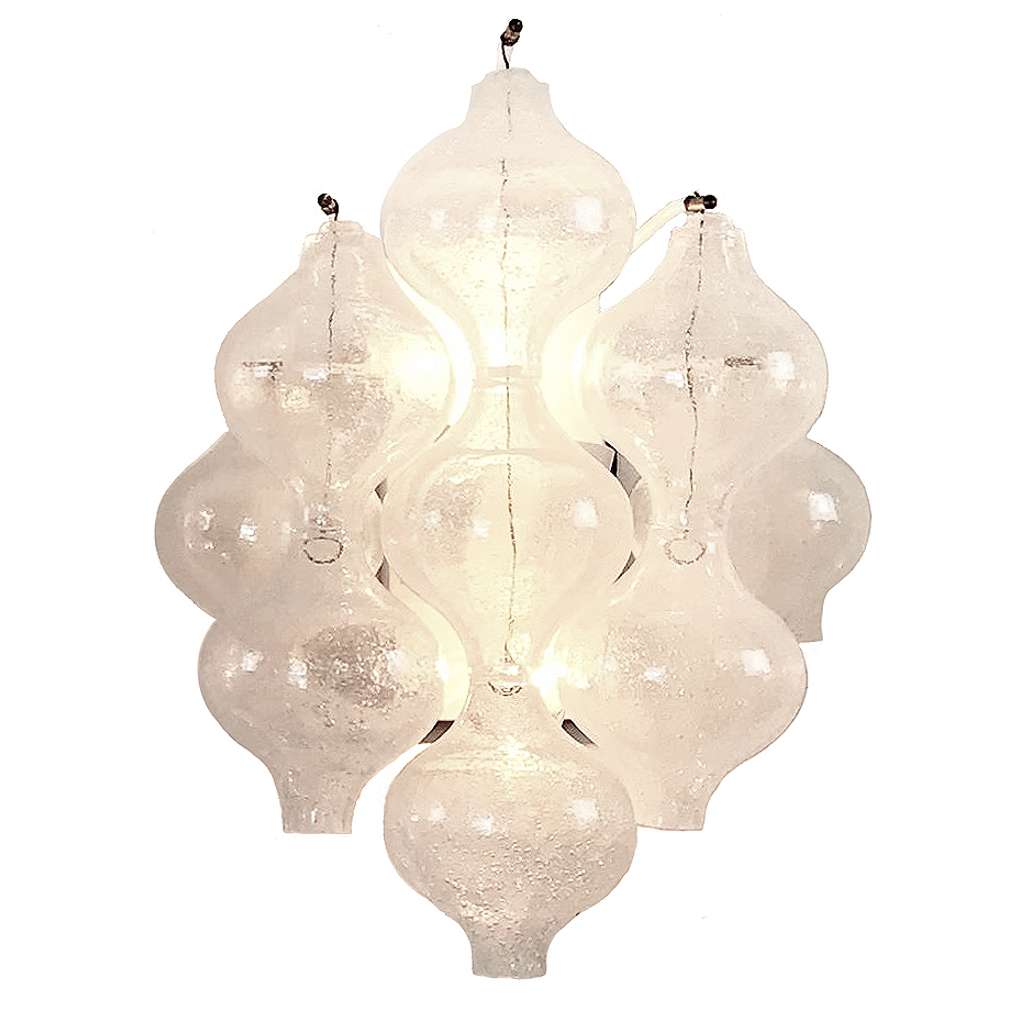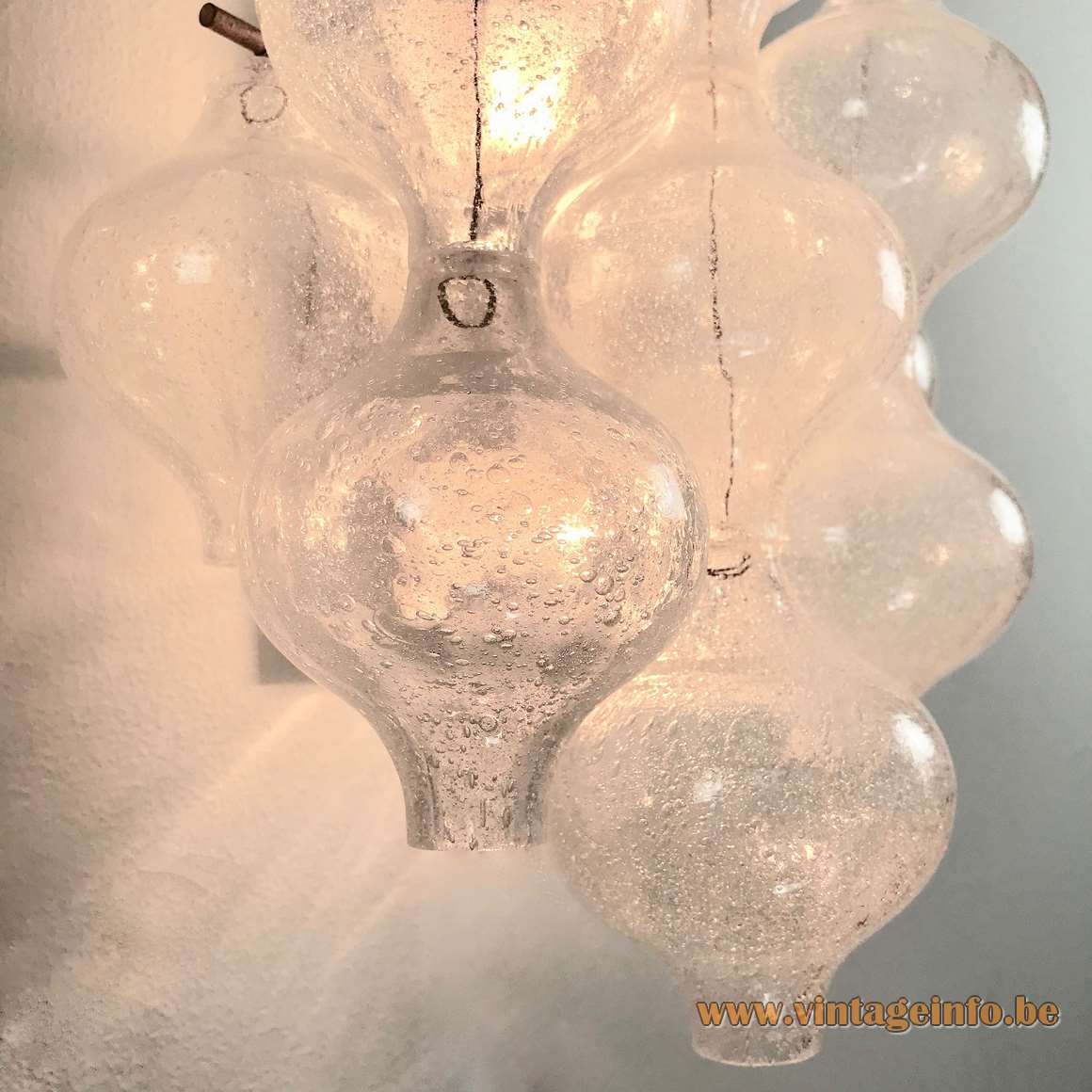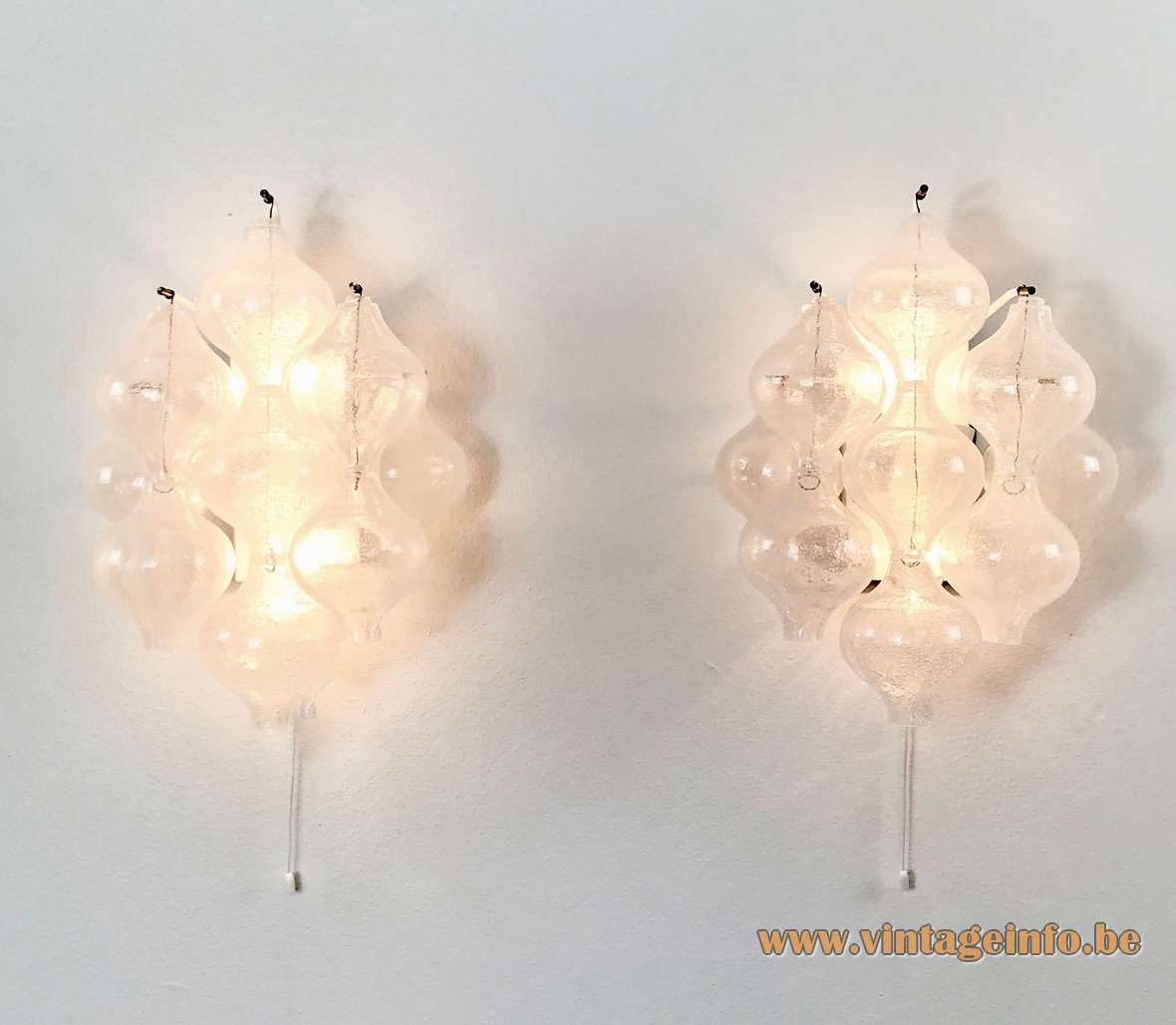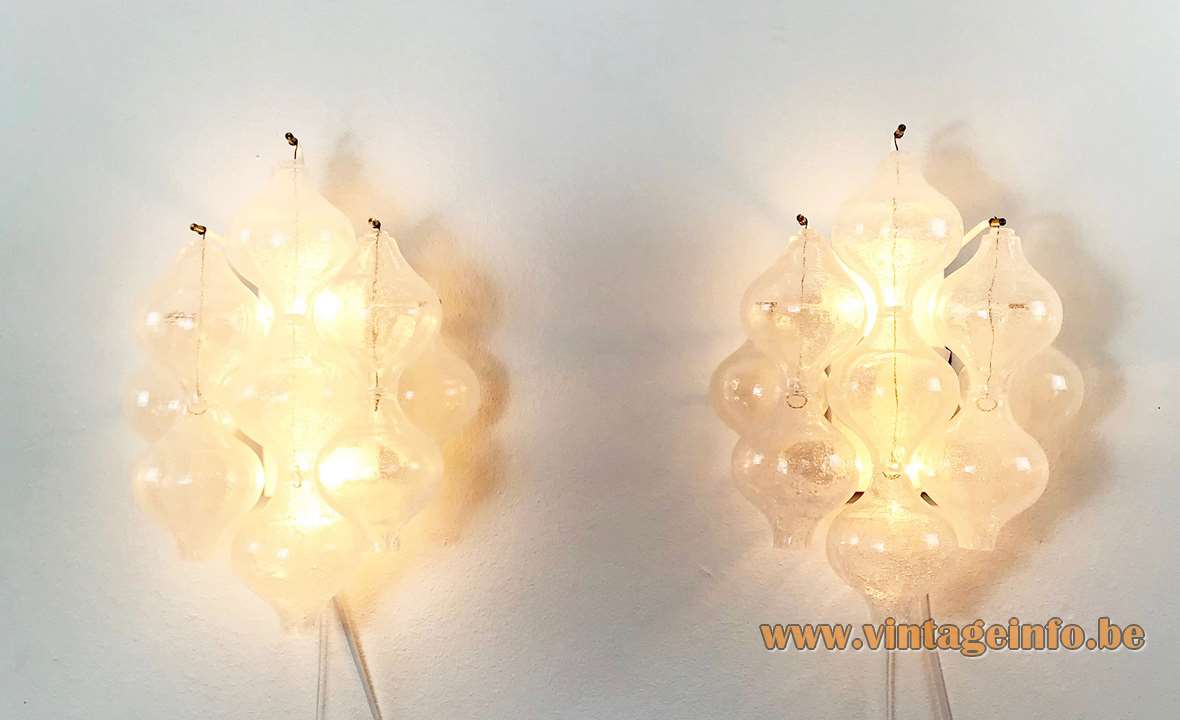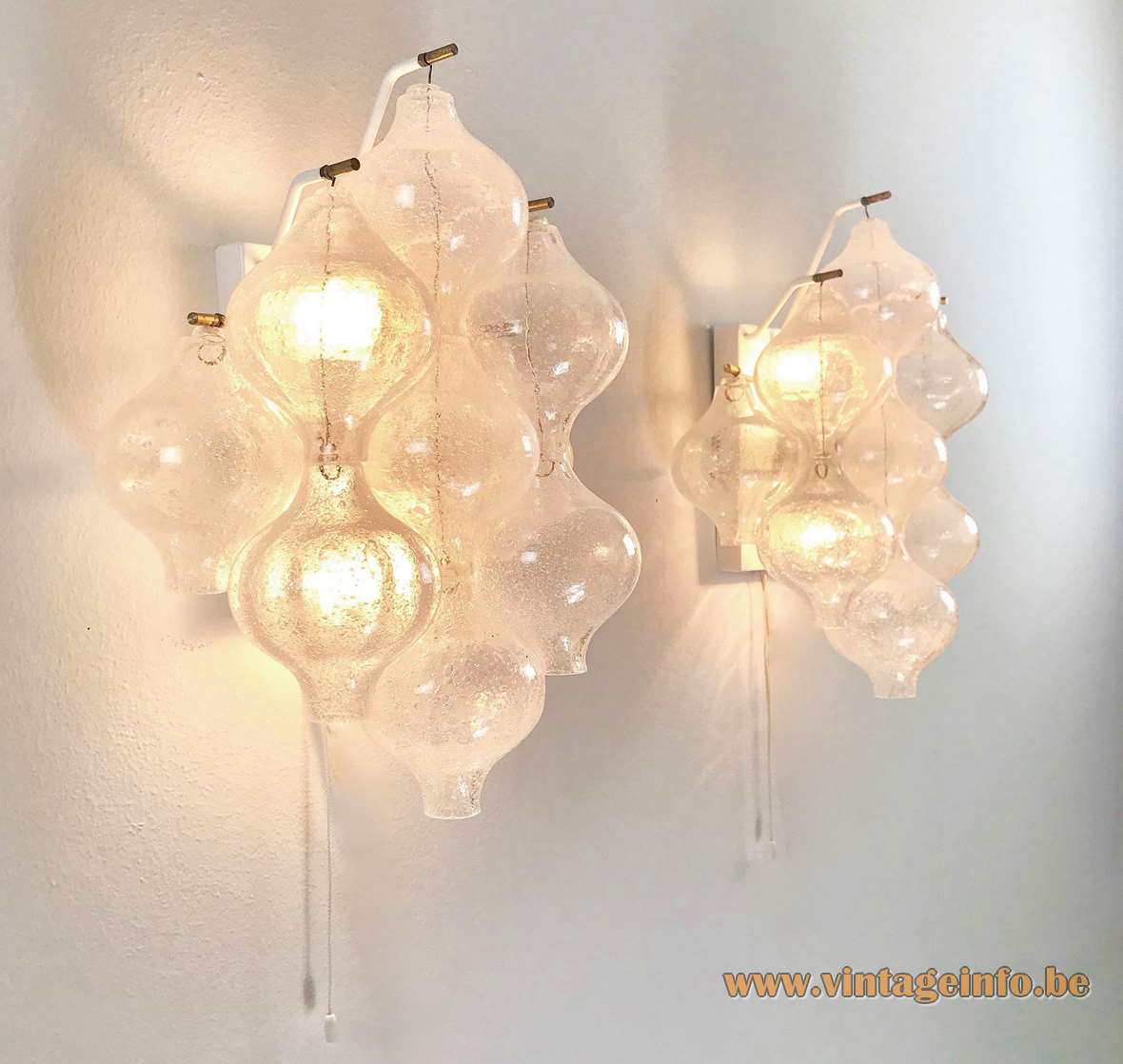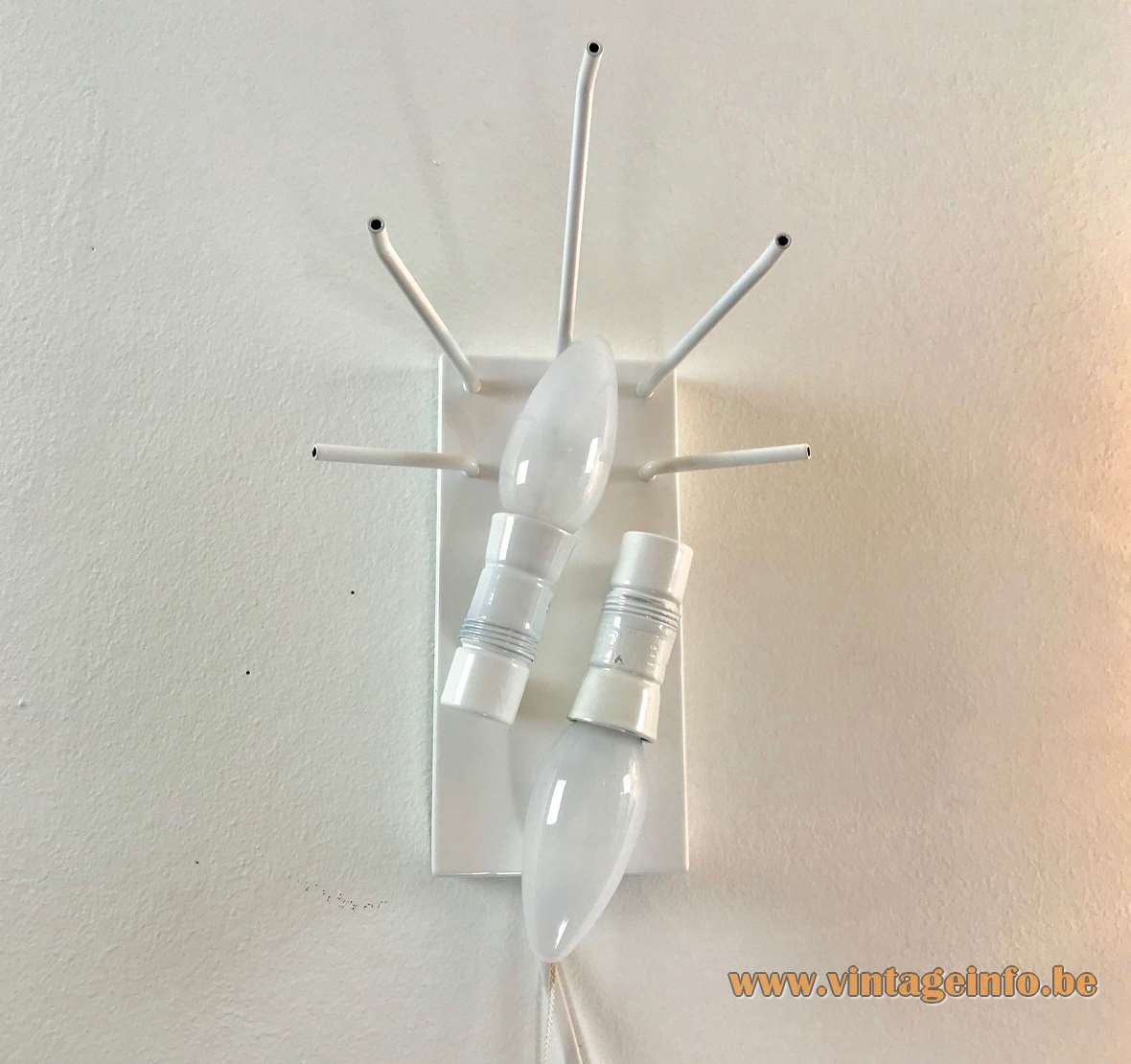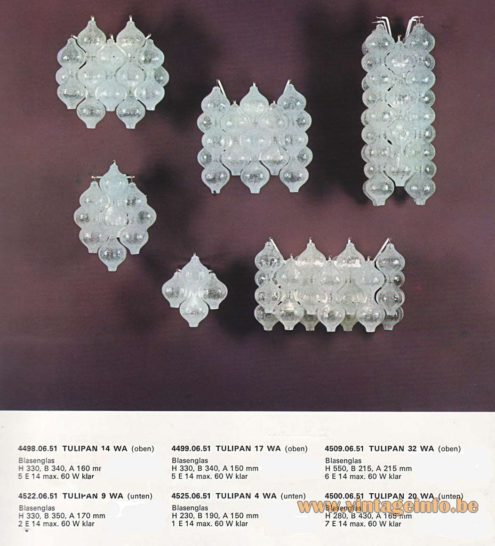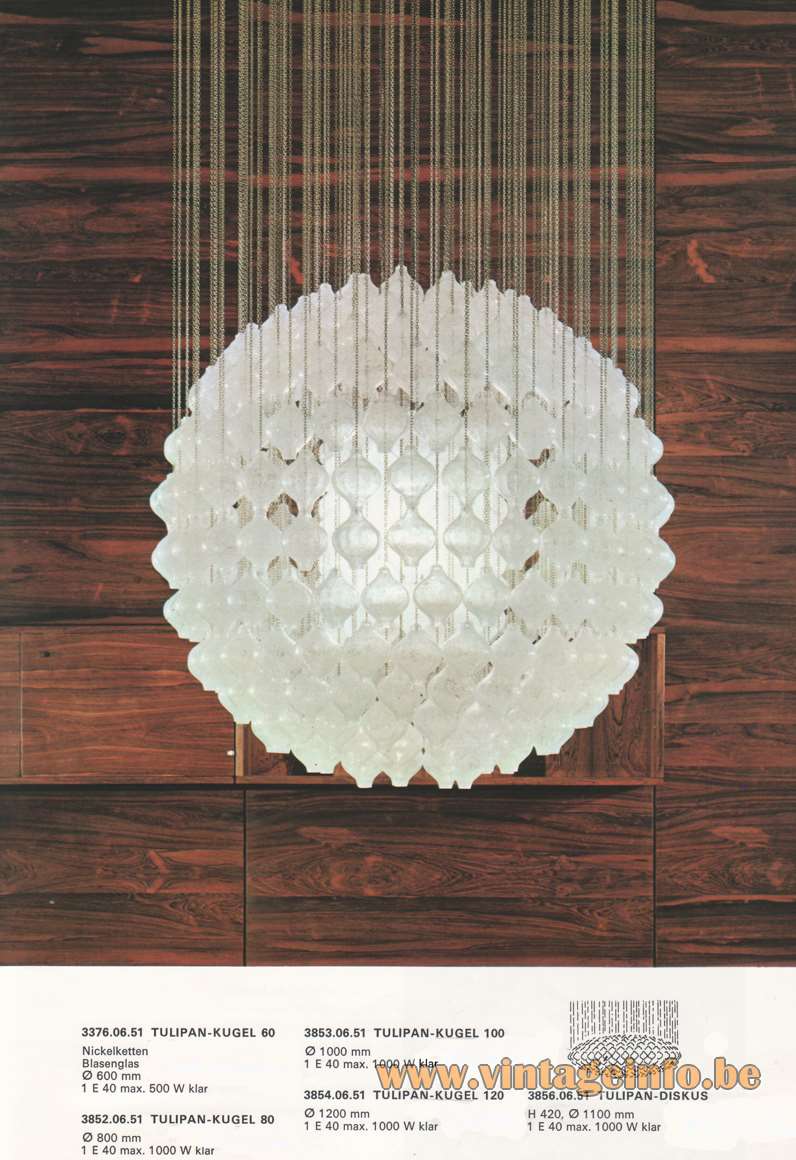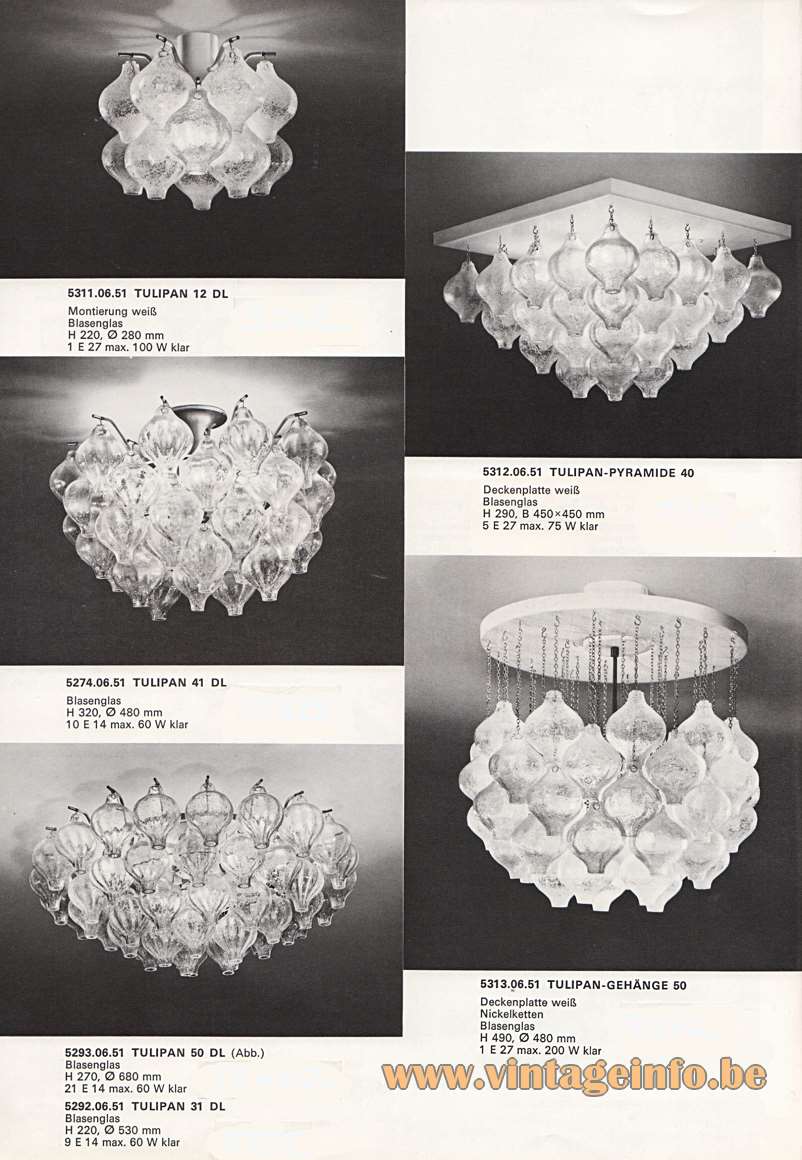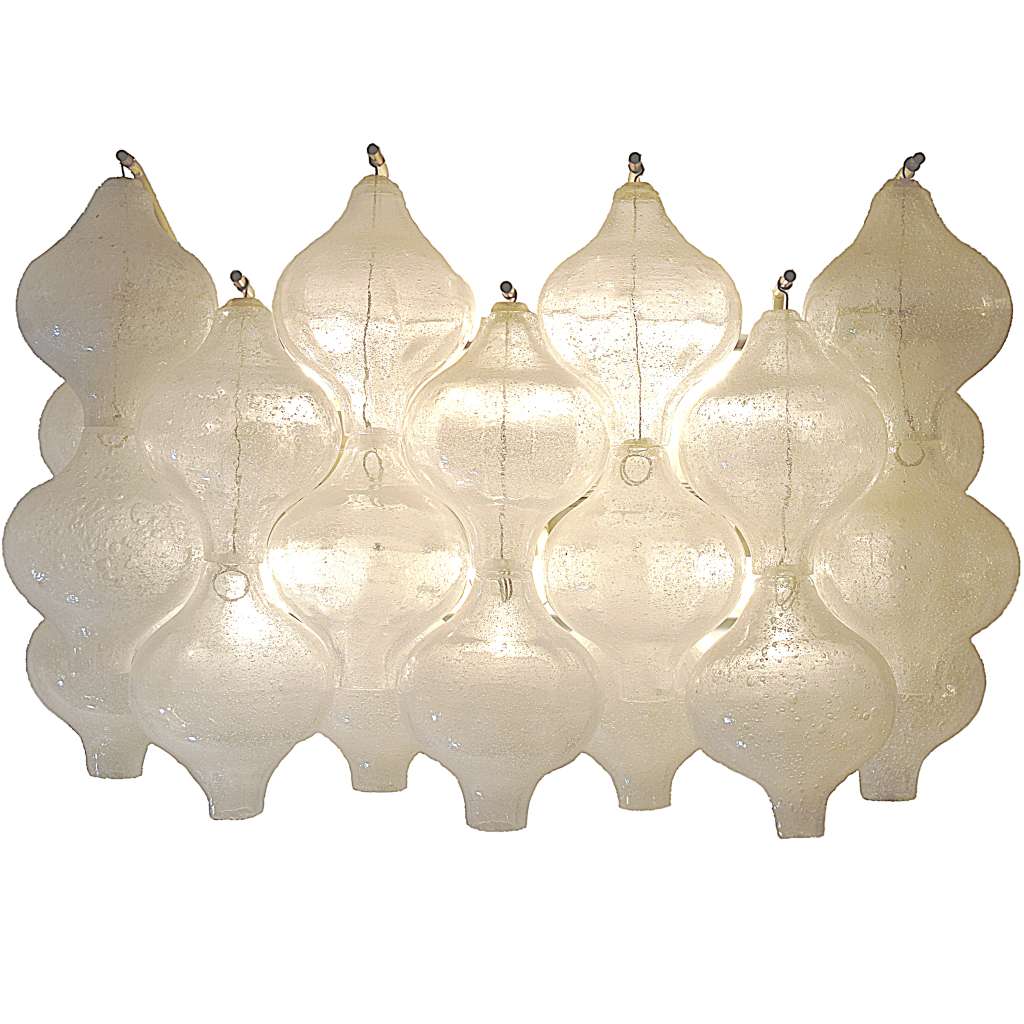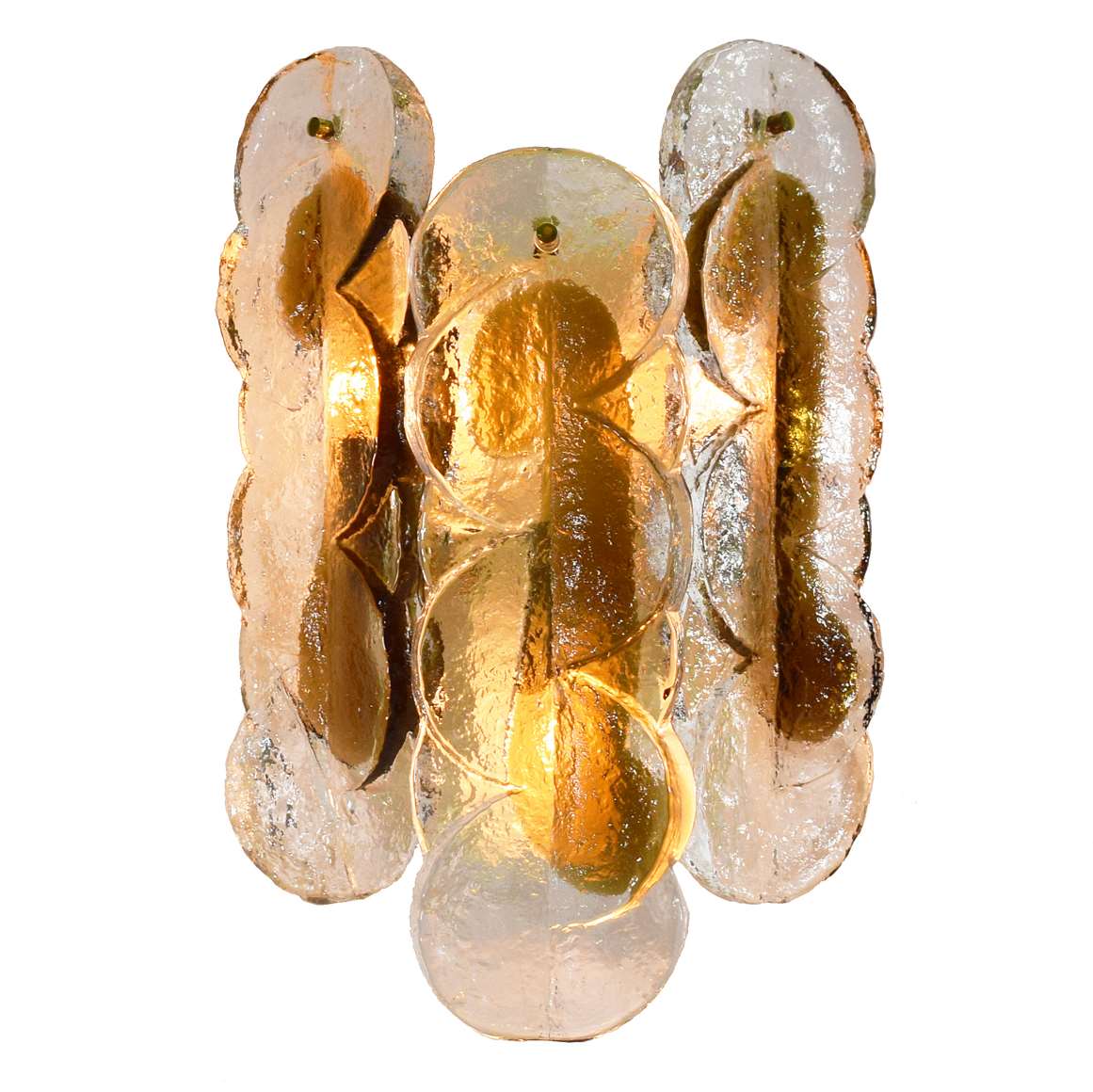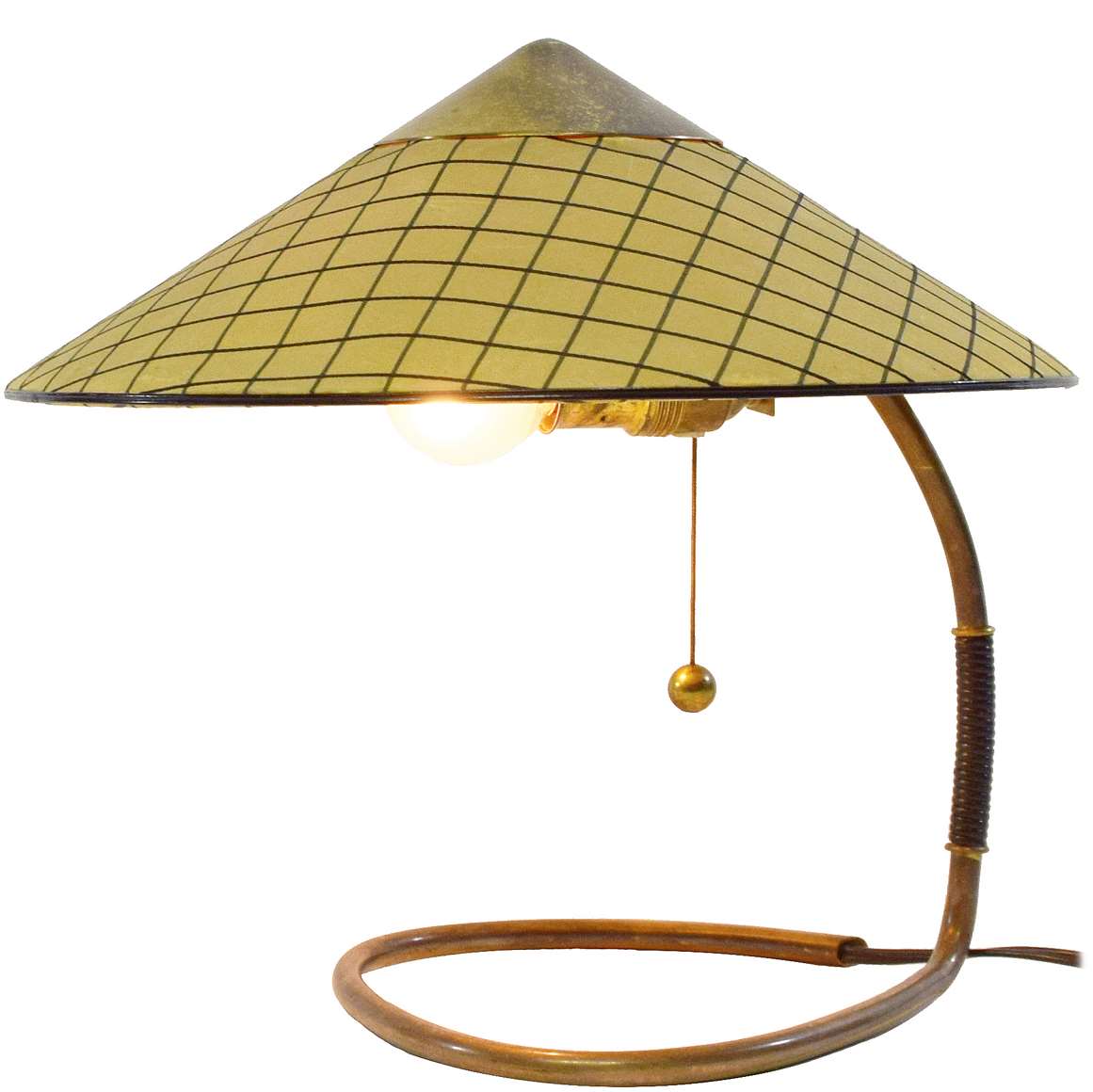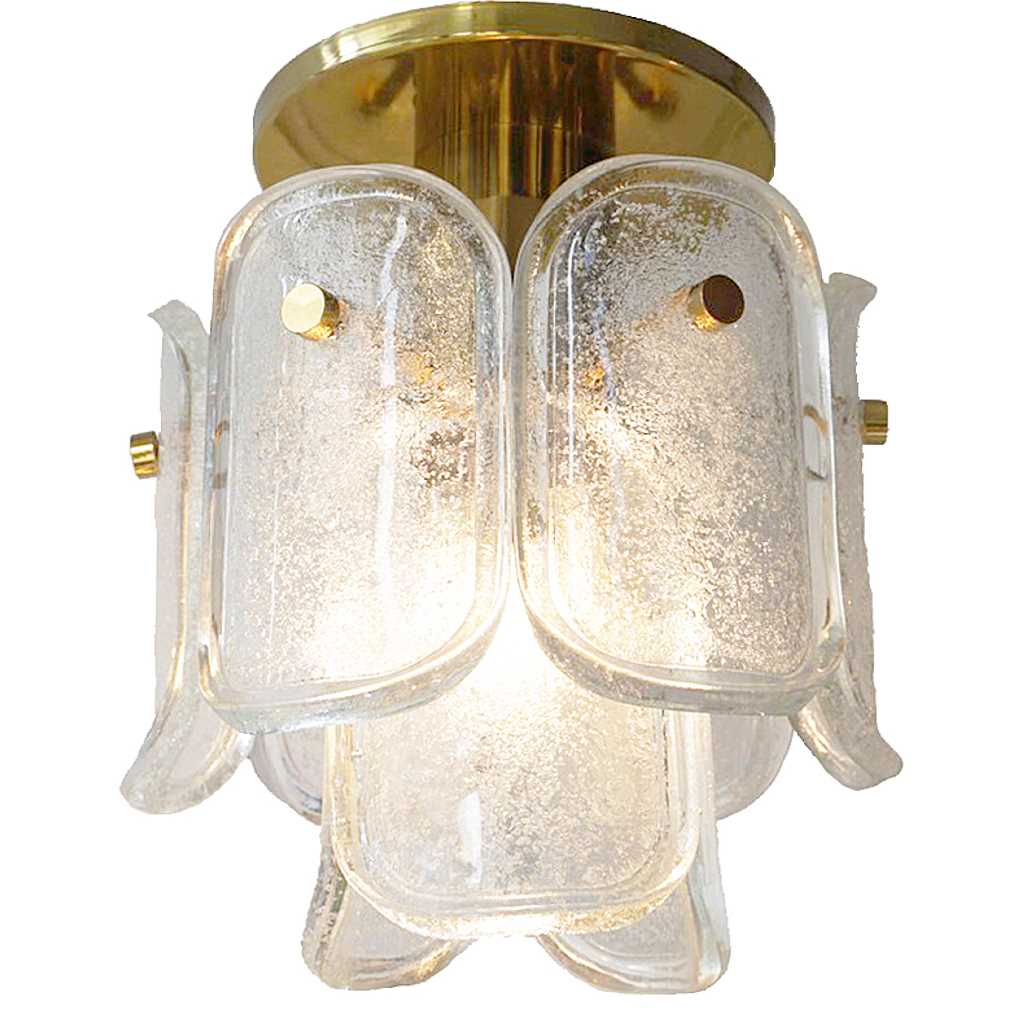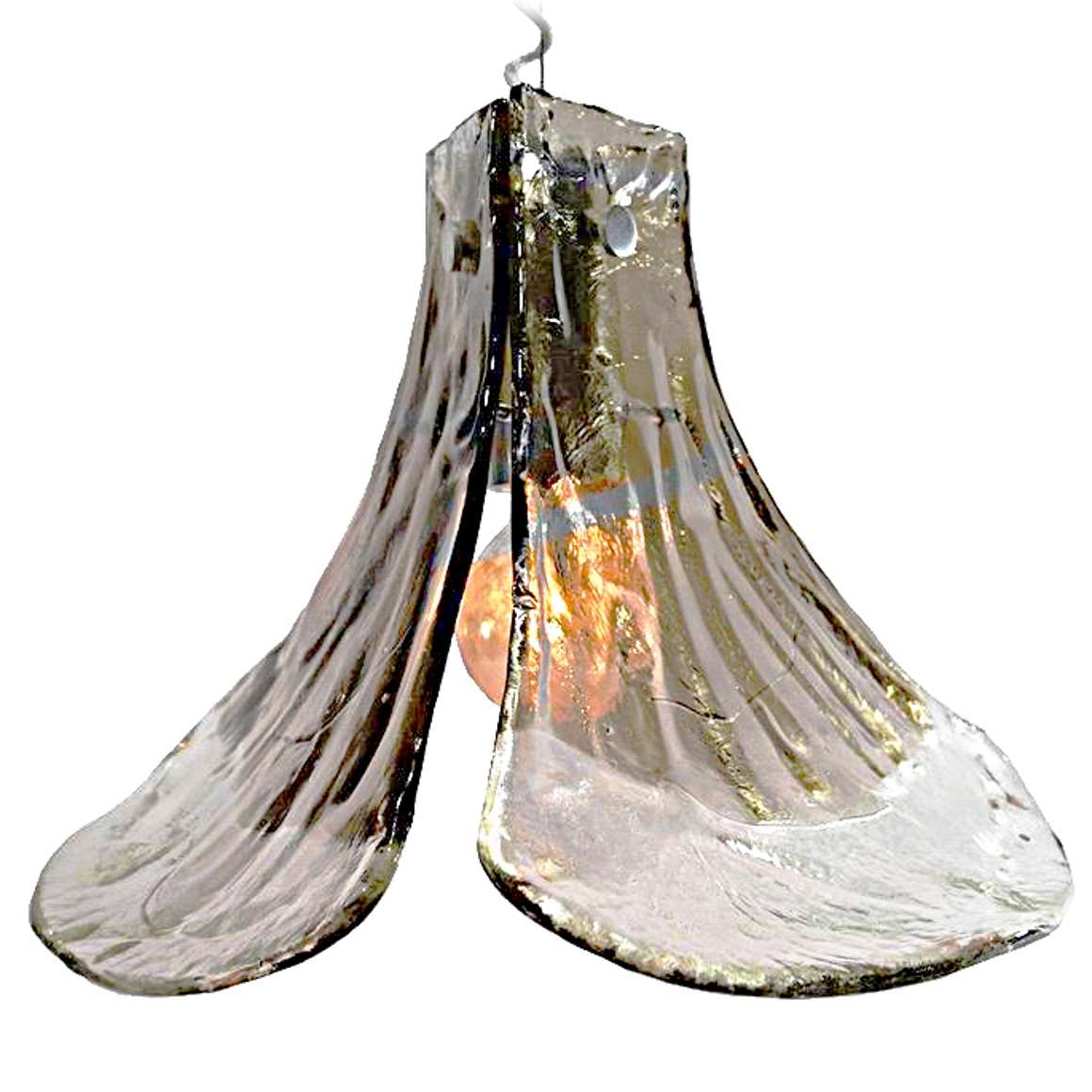Kalmar Franken KG Tulipan Wall Lamp 9 WA – 1970 & 1972 Catalogue Picture
Kalmar Franken KG Tulipan Wall Lamp 9 WA – 1970 & 1972 Catalogue Picture
Here together with all the other wall lamps.
Kalmar Franken KG Tulipan Wall Lamp 9 WA – 1970 & 1972 Catalogue Picture
A very impressive and heavy chandelier.
Kalmar Franken KG Tulipan Wall Lamp 9 WA – 1970 & 1972 Catalogue Picture
Several ceiling lamps or flush mounts, many other models exists.
Links (external links open in a new window)
Facebook of Kalmar Werkstaetten
Vintageinfo
Tulipan 20 WA wall lamp – 20 glass bulbs model
Tulipan ceiling lamp – 24 glass bulbs model
Many thanks to Hans from Objeta for the beautiful pictures and the enthusiasm.
Kalmar Tulipan 9 WA Wall Lamp
Materials: White painted metal frame, folded rods and brass ornamental nuts. 9 hand blown crystal bubble glass “Tulipan” tulip, onion bulbs. 2 Metal E14 sockets.
Height: 33 cm / 12.99”
Width: 35 cm / 13.77”
Depth: 17 cm / 6.69”
Electricity: 2 bulbs E14, 2 x 40 watt maximum, 110/220 volt.
Anytypeof light bulb canbeused, not a specific one preferred. However, small clear light bulbs gives the best result.
Period: 1970s – Mid-Century Modern.
Designer: Carlo Nason.
Manufacturer: Kalmar Franken KG, Vienna, Austria.
Other versions: The tulip/onion bulbs of this Kalmar Tulipan 9 WA wall lamp were also used for chandeliers, ceiling lamps, flush mounts and many other types of lamps. From small to big lamps in all forms and sizes. You can find the Tulipan lamps and many others in a catalogue here on Vintageinfo: J.T. Kalmar KG, Franken KG – Catalogue 1972. They were made in several colours, at least also made in amber bubble glass.
These glass tulip bulbs are made with small bubbles inside the glass. The technique is named pulegoso. It was made by AV Mazzega, Murano, Italy.
Pulegoso
Italian word taken from the dialect word pulega, which means bubble. The glass is containing numerous bubbles of all sizes, produced by adding bicarbonate/soda, gasoline, or other substances to the glass. The bubbles make the glass semi-opaque and give the surface an irregular texture. The technique was developed in the 1920s by Napoleone Martinuzzi (1892-1977) on the island of Murano, Italy and used for the first time by the famous Venini company.
Kalmar Franken KG
Founded in Vienna by Julius August Kalmar in the 1880s, Kalmar first specialized in the production of hand crafted objects of cast bronze. The company soon established its practice of closely collaborating with prominent architects to create chandeliers and other cast bronze objects in Austria, Europe and the United States. Before long it was presenting custom-made wares at international exhibitions such as the 1888 Vienna Trade Exposition (Gewerbeausstellung Wien). The 1893 Chicago World’s Columbian Exposition. The 1901 Export Exposition Scandinavia and the 1906 Austrian Exhibition in Earl’s Court, London.
Julius Theodor Kalmar
After the turn of the century, Julius Theodor Kalmar, son of the original founder, studied under the renowned Austrian architect and designer Josef Hoffmann at the Vienna School of Applied Arts and the Birmingham School of Art and Design. Inspired by Josef Hoffmann and the arts and crafts movement of the era, Julius pushed the company in a new direction away from the eclectic style of the late 19th century. And in 1925 Kalmar designs began selling in Haus und Garten, an avant-garde shop for home furnishings founded by architects and designers Josef Frank and Oskar Wlach. The shop was to become a main venue of modern Austrian interior and lighting design. It has a trademark in the promotion of Viennese design abroad.
By 1931, Kalmar was concerned solely with designing and manufacturing high quality lamps and fixtures in cooperation with the architects of the Austrian Werkbund, an association of artists, craftsmen, architects and manufacturers founded in 1912. Their purpose was the promotion of a high regard for material, form and function in the hand crafted as well as industrial production of fine art and applied arts. They sought modernity by combining classical tradition and contemporary innovation. Recognized as a typically Viennese style by the 1930s, this “moderate modernity” integrated the ornament-stripped purism of Adolf Loos with more traditional elements.
Julius Theodor Kalmar saw lighting fixtures as “quite humble things, which fit in and serve their purpose of functionally illuminating living spaces without glare — and that is what it all comes down to, as far as lamps are concerned as well as in all aspects of life: fitting in with the given framework and with the overall concept.”
Designers
Thanks to the younger Kalmar’s involvement and personal acquaintance with the leading European architects of the day, the name Kalmar became associated with high quality modern design. The company flourished, producing light fittings for prominent Austrian architects and designers including Frank and Wlach. As well as Oskar Strnad, Clemens Holzmeister, Oswald Haerdtl, Ernst Plischke, and others. As the company grew, the size and scope of its contracts increased. And soon it was producing chandeliers and major installations for clients such as the Vienna Opera, the Burgtheater, the new theaters in Linz and Salzburg and the Vienna stock exchange.
During the 1960s and 70s, Kalmar became increasingly involved in the production of decorative glass objects. Initially designed for the retail market, the company’s mouth-blown and molded relief glass elements offered vast decorating possibilities in large or small areas.
As a result, the demand for Kalmar installations grew steadily. The company became more widely known among international design and architecture professionals.
1990s until today
In the 1990’s, the great-grandson of the founder, Thomas Calice, shifted the company’s focus to international lighting projects. He phased out Kalmar’s own product lines and concentrated the company’s resources on the production of decorative, functional and technical lighting installations. The company has expanded in this specialized area and now produces prestigious custom designed and manufactured lighting installations throughout the world.
Lighting Installations
In recent years Kalmar has produced major lighting installations for government buildings and palaces, museums, theaters, hotels and cruise ships. These projects include the Presidential Palace of the Kremlin. The State Tretjakov Gallery in Moscow, the new Shanghai Grand Theater. Hotels including the Ritz Carlton in Berlin, Doha and Osaka. The Grand Hyatt in Dubai, the W-Hotel in Doha. Shangri-la hotels in Abu Dhabi, Beijing and Suzhou. The Hilton in Adelaide, Bahrain, Bangkok, London and Seoul and the Sheraton in Cairo, Frankfurt and Stockholm. As well as cruise ships such as Royal Caribbean International’s Voyager, Freedom and Genesis class ships and the Cunard Line’s RMS Queen Mary 2 and MS Queen Victoria. In addition to the Dubai and Jeddah Airports, the Burj Tower and the Qatar Education City Convention Center.
*In collaboration with Jonathan Browning Inc., a producer of highest quality lighting for interior designers and architecture firms, Kalmar Werkstätten, a sub brand of Kalmar, is currently offering reproductions of a series of seven historic designs based on Kalmar drawings to some of their American clients. Their distinct, simple elegance clearly evokes the essence and spirit of the Austrian Werkbund. Kalmar will also be marketing these designs in Europe, the Middle East and Asia. In addition, United Designers Ltd, an award winning, multidisciplinary consultancy based in London has adapted a selection of Kalmar designs for marketing in 2009. In march 2016 United Designers Ltd was dissolved after 22 years. Last accounts were made up to 31 March 2011.
Carlo Nason
Carlo Nason was born in Murano in 1935 into one of the island’s oldest glassmaking families. His father, Vincenzo Nason, founded V. Nason & C., where Carlo was introduced to the most refined glassmaking techniques.
Although his formal studies were in economics and administration, his true education came at the furnace, where he mastered traditional skills while developing a passion for design, photography, and graphics. His earliest works from the late 1950s are still preserved today in the collection of the Corning Museum of Glass, New York.
In the 1960s he began working formally for the family glassworks but quickly expanded beyond it, collaborating with other Murano workshops and pursuing a distinctly modern vision. His designs combined craftsmanship and innovation, balancing Murano traditions with the clean forms and modularity of contemporary design.
Collaboration with AV Mazzega
From the mid-1960s until the 1980s, Carlo Nason designed an entire generation of lamps for AV Mazzega. Under Gianni Bruno Mazzega ’s direction, he enjoyed extraordinary creative freedom. He explored vetro in piastra, opaline, pulegoso, and layered glass, developing the poetic, diaphanous lighting effects that became his signature.
Unlike many designers, Nason oversaw the entire production process – from drawings to kiln work and metal fittings – ensuring absolute precision. These years produced numerous icons of Italian design, today regarded as cornerstones of Mazzega’s history.
Collaboration with Kalmar
In the early 1970s, AV Mazzega introduced Nason to Kalmar Franken KG in Vienna. Kalmar, with its tradition of working closely with architects, was then expanding into modern glass lighting. Nason’s minimalist and modular approach proved an ideal match.
For Kalmar he designed systems such as RS-System, Meander and Mare, conceived for both domestic interiors and large-scale architecture. Even more enduring were his decorative series – the famous Tulipan, Citrus, Granada, Sierra, Pagode and Stein collections. Produced with Murano glass and Kalmar’s metal craftsmanship, these ranges became commercial successes across Europe, cementing Kalmar’s reputation in international lighting design.
Other collaborations
Beyond AV Mazzega and Kalmar, Nason designed for Vistosi, De Majo, Leucos, Alt Lucialternative, Gallery Vetri d’Arte, Murano Due, Selenova, Linea GB, IVL, and Gruppo Firme di Vetro, among others. With Lumenform, he created the famous Sona pendant lamp (1970), later reissued by ITre, for which he also designed the popular Opera lamp in the 1990s. For Murano Due, his creations included Bolero, Contessa, Chimera, and Ghost, later entering the Leucos catalogue. At de Majo, he developed the Boccioni vases and the Bilbao lamp, proving his ability to work with materials beyond glass.
His versatility extended beyond lighting: he designed ceramics for Baldelli, ski boots for Garmont, perfume flacons for fashion designers, and served as lighting consultant for Casinos Austria International in Vienna.
Photography and exhibitions
Equally passionate about photography, Nason won numerous competitions during the 1960s and 70s. His images, often commissioned for Murano catalogues, reflected the same modern sensibility as his lamp designs.
In 2015, on his 80th birthday, the Triennale di Milano dedicated a solo exhibition to his work, recognizing him as one of Murano ’s most important postwar designers. His creations are held in major museum collections, including the Museum of Modern Art (MoMA) in New York, the Triennale Design Museum in Milan, and the Corning Museum of Glass in New York, which owns an extensive collection of his work.
Legacy
Carlo Nason has always been a discreet figure, avoiding the spotlight, yet his designs have reached a wide audience—from museum halls to television screens in the 1980s. His career represents the very best of Italian lighting design: rooted in Murano ’s heritage yet always open to innovation, modernity, and international collaboration.
